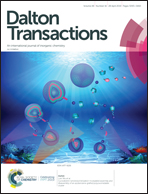Enhanced Néel temperature in EuSnP under pressure†
Abstract
We present the combined results of single crystal X-ray diffraction, physical properties characterization, and theoretical assessment of EuSnP under high pressure. Single crystals of EuSnP prepared using Sn self-flux crystallize in the tetragonal NbCrN-type crystal structure (S.G. P4/nmm) at ambient pressure. Previous studies have shown that for Eu ions, seven unpaired electrons impart a 2+ oxidation state. Assuming the oxidation states of Eu to be +2 and P to be −3, each Sn will donate one electron, with one p valence electron left for forming a weak Sn–Sn bond. According to the high-pressure single crystal X-ray diffraction measurements, no structural phase transition was observed up to ∼6.2 GPa. Temperature-dependent resistivity measurements up to 2.15 GPa on single crystals indicate that the phase-transition temperature occurring at the Néel temperature (TN) is significantly enhanced under high pressure. The robust crystallography and enhanced antiferromagnetic transition temperatures can be rationalized by the electronic structure calculations and chemical bonding analysis. The increasing Eu–P bonding interaction is consistent with the lattice parameter changing and enhanced TN. Moreover, the molecular orbital diagram shows that the weak Sn–Sn bond can be squeezed under pressure, acting as a compression buffer to stabilize the structure.



 Please wait while we load your content...
Please wait while we load your content...
